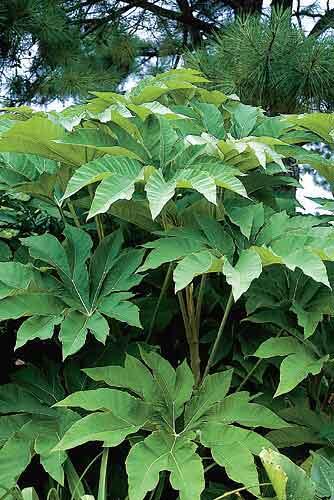The Plant
Tetrapanax papyiferum (Hook.) Koch
Pith paper is not "rice-paper" as it is commonly labeled. The smooth, bone white paper is made from the pith of the Tetrapanax papyriferum (Hook.) plant, which is a member of the Araliaceae (ginseng) family. It is native to Southern China and Taiwan, but was not investigated by Western botanists until the early and mid-nineteenth century. Pith paper has been used to make artificial flowers and decorative hairpins in China for centuries, while in the 1800s it became extremely popular as a surface for painting with watercolors and tempera. These paintings were bound in books with silk "tape" and usually depicted scenes from daily life, including plants, animals, occupations, customs and costumes. In China and Taiwan, the plant was referred to as "tung-tsao", meaning 'hollow-plant', "toong-tsao", or "bok-shung".
Tetrapanax papyriferum remained a mystery to botanists for many years. Western explorers brought back to England tales of the plant and samples of the pith paper. There it was studied by botanists that included Sir William J. Hooker. This paper was followed by dried specimens, leaves, and stems of the plant itself, and finally a living plant arrived in England in the 1850s.
Habitat and Description of Tetrapanax papyriferum

The plant itself is described as a small tree or shrub; its height varies between 4 and 12 feet, but has been know to grow as tall as 30 feet. The leaves can be as large as 2 1/2 feet wide and are deeply serrated, with a leaf stem of up to 3 feet in length and 1/2 inch in diameter. The bark is described as rough, and the wood itself is very hard and dense. Tetrapanax papyriferum grows best in soils that are rich in organic material, but is capable of growing in clay or gravel soils as well. It grows rapidly in its first few years and reaches maturity around the 4th and 5th year.